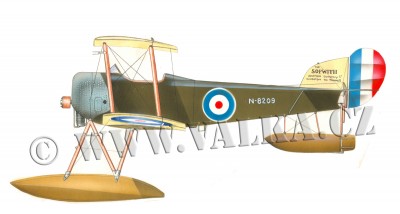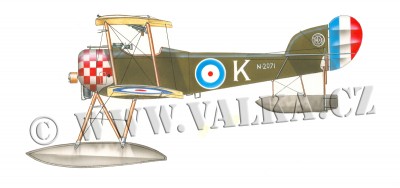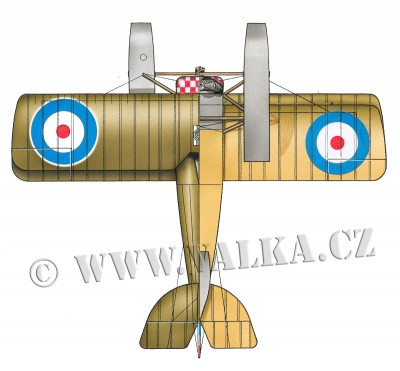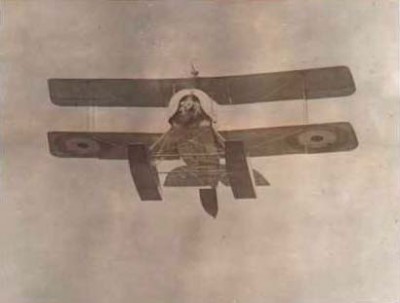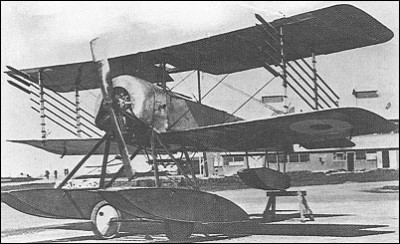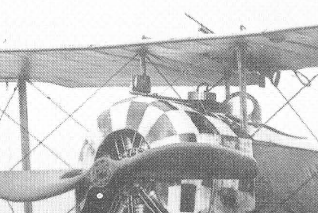| Název: Name: | Sopwith Baby | Sopwith Baby |
| Originální název: Original Name: | Sopwith Baby | |
| Kategorie: Category: | průzkumný/pozorovací letoun | reconnaissance/scout aeroplane |
| Výrobce: Producer: | DD.MM.1916-DD.MM.191R The Sopwith Aviation Co., Ltd., Kingston DD.MM.1916-DD.MM.191R Blackburn Aeroplane & Motor Co., Ltd., Leeds DD.MM.1917-DD.MM.1918 SA Aeronautica Gio. Ansaldo, Torino | |
| Období výroby: Production Period: | DD.MM.1916-DD.MM.1918 | |
| Vyrobeno kusů: Number of Produced: | ~386 (180 dalších postaveno jako Hamble Baby): 100 Sopwith 186 Blackburn ~100 Ansaldo | |
| První vzlet: Maiden Flight: | DD.MM.RRRR | |
| Osádka: Crew: | 1 | |
| Základní charakteristika: Basic Characteristics: | ||
| Vzlet a přistání: Take-off and Landing: | CTOL - konvenční vzlet a přistání | CTOL - conventional take-off and landing |
| Uspořádání křídla: Arrangement of Wing: | dvouplošník | biplane |
| Uspořádání letounu: Aircraft Concept: | klasické | conventional |
| Podvozek: Undercarriage: | pevný | fixed |
| Přistávací zařízení: Landing Gear: | plováky | floats |
| Technické údaje: Technical Data: | ||
| Hmotnost prázdného letounu: Empty Weight: | 583 kg | 1286 lb |
| Vzletová hmotnost: Take-off Weight: | 778 kg | 1715 lb |
| Maximální vzletová hmotnost: Maximum Take-off Weight: | ? kg | ? lb |
| Rozpětí: Wingspan: | 7.82 m | 25ft 8in |
| Délka: Length: | 7.01 m | 23ft |
| Výška: Height: | 3.05 m | 10ft |
| Plocha křídla: Wing Area: | 22.3 m2 | 240 ft2 |
| Plošné zatížení: Wing Loading: | ? kg/m2 | ? lb/ft2 |
| Pohon: Propulsion: | ||
| Kategorie: Category: | pístový | piston |
| Počet motorů: Number of Engines: | 1 | |
| Typ: Type: | Gnome 9B, o výkonu 75 kW nebo Clerget 9Z o výkonu 82 kW nebo Le Rhône 9J o výkonu 82 kW nebo Clerget 9B o výkonu 97 kW dvoulistá dřevěná vrtule | Gnome 9B, power 100 hp, or Clerget 9Z, power 110 hp, or Le Rhône 9J, power 110 hp, or Clerget 9B, power 130 hp two-blade wooden propeller |
| Objem palivových nádrží: Fuel Tank Capacity: | 114 l | 25 Imp gal |
| Výkony: Performance: | ||
| Maximální rychlost: Maximum Speed: | 160.9 km/h v 0 m | 100 mph in 0 ft |
| Cestovní rychlost: Cruise Speed: | ? km/h v ? m | ? mph in ? ft |
| Rychlost stoupání: Climb Rate: | ? m/s | ? ft/min |
| Čas výstupu na výšku: Time to Climb to: | 11 min do 1981 m | 11 min to 6500 ft |
| Operační dostup: Service Ceiling: | 2438 m | 8000 ft |
| Dolet: Range: | ? km | ? mi |
| Maximální dolet: Maximum Range: | ? km | ? mi |
| Výzbroj: Armament: | 1x pevný 7,7mm kulomet Lewis na trupu nebo nad horním křídlem 2x 29kg bomba nebo 4x 9kg bomba 10x raketa Le Prieur | 1x fixed .303 Lewis machine gun on fuselage or top plane mounting 2x 65 lb bomb or 4x 20 lb bomb 10x Le Prieur rocket |
| Uživatelské státy: User States: | | |
| Poznámka: Note: | Vytrvalost: 2,25 h | Endurance: 2.25 hr |
| Zdroje: Sources: | Cooklsey, Peter. Sopwith Fighters in Action: Aircraft nrumber 110. Squadron/Signal Publications, Inc. 1991 ISBN 0-89747-256-X. Davis, Mick. Sopwith Aircraft, Crowood Press, Ramsbury 1999. ISBN 1-86126-217-5. www.mil.no | |
Sopwith Baby
description
It was the next evolutionary stage following the Sopwith Schneider. The design remained essentially the same. A single-seat biplane with a cockpit under the upper wing, with wings of the same span and a canvas-covered wooden airframe. The landing gear consisted of two large main floats and one small float at the rear of the aircraft. A change was to equip the aircraft with a nine-cylinder Clerget rotary engine of 110 or 130 hp, which drove a two-bladed wooden propeller with a diameter of 2.6 metres. Furthermore, the engine cowling was modified and given the characteristic inverted-U (horseshoe) shape. All four wings were fitted with flaps. The armament consisted, as on the Schneider, of a Lewis machine gun mounted in a cut-out in the upper wing, firing upwards and forwards; on later models, the mounting of the machine gun was changed - a synchronized Vickers 7.7 mm (0.303 in) machine gun now fired forwards through the propeller circuit. The Sopwith Baby could carry two 65lb bombs used in anti-submarine patrols.
It was deployed on light cruisers, seaplane carriers and other types of ships (e.g. HMS Vindex, HMS Engadine, HMS Campania). Use on submarines was also considered. Sopwithy Babies were also deployed at coastal air bases in England. The main task was to stop Zeppelins bombing Britain. For this task they initially used Ranken Darts - incendiary darts designed to pierce the airship's hull and explode inside the gas bag. They also operated in the Mediterranean either from land bases (Thasos, Otranto, Imbros) or from ships (HMS Ark Royal, HMS Ben-My-Chree). For example, in January 1918, aircraft from the Ark Royal attacked and bombed the Turkish cruiser Yavuz Sultan Selim (originally SMS Goeben) near the Dardanelles. However, the bombs used were too small to cause serious damage to the ship. From 1916, Sopwith Baby aircraft also operated in Dunfermline.
The Sopwith Baby was produced not only by the Sopwith Aviation Company but also by other manufacturers - Blackburn Aeroplane Company, Fairey Aviation Company and Parnall and Sons. It was common for each manufacturer to produce an aircraft with a slightly different design and equipment. The Blackburn Aeroplane Company produced aircraft essentially the same as the original from the Sopwith factory. The Fairey Aviation Company produced aircraft with arched wingtips with flaps, altered rudder and improved floats. Parnall and Sons produced machines identical to Sopwith but with arched wingtips like Fairey. Sopwith Baby machines were also licensed by the SA Aeronautica Gio Ansaldo factory in Turin, Italy.
Aircraft produced by Fairey and Parnall and Sons are also referred to as Hamble Babies due to their design differences.
Number of units produced:
100 pieces - Sopwith Aviation Company
186 - Blackburn Aeroplane Company
130 pcs - Fairey Aviation Company
50 units - Parnall and Sons
Sopwith Baby aircraft were used by the air forces of Canada, Australia (including HMAS Brisbane), USA, France (designated Sopwith 130 ch Clerget), Chile, Greece and Norway.
Sopwith Baby operations in Norway
In the summer of 1917, Great Britain was annoyed by Norwegian Naval Air Force (Marinens Flyvevesen (MF)) officers H. Riiser-Larsen and F.A. Horgen. The aim of their trip was to obtain modern aircraft for the MF. The negotiations were successful and so in 1917 the Norwegian Naval Air Force ordered ten Sopwith Baby machines.
The first four arrived in 1917, the remaining six were delivered a year later. They were designated F.100 - F.118 (the Navy used only even numbers, the Army Air Force only odd numbers) and were equipped with a 130 hp engine. Norwegian Sopwiths took off from bases in Horten, Haugesund and Kristiansand.
In 1923, the F.104 was to cooperate in a polar expedition in which Roald Amundsen wanted to fly over the North Pole in a Junkers F-13. The expedition failed and so the aircraft only made a few flights to Svalbard. In 1928, Sopwiths Baby numbers F.100 and F.102 aboard the heavy cruiser KNM Tordenskjold were sent to Svalbard to help find Amundsen and his companions who had disappeared while searching for Umberto Nobile's airship Italia. As is well known, they were unsuccessful.
There were also trials in Norway with the substitution of floats for a conventional chassis fitted with wheels, and experimentation with a ski chassis. All tests were successful.
The last Sopwith Baby ended its service in December 1931. In total, these aircraft flew over 1,500 hours in Norway. They had a number of crashes, only one of which resulted in the death of the pilot, and by the end of their service life, thanks to many repairs and modifications, they were quite different from the original machines.
[1] COOKSLEY, Peter. Sopwith Fighters in Action: Aircraft nrumber 110. Squadron/Signal Publications, Inc. 1991 ISBN 0-89747-256-X
[2] www.britishaircraft.co.uk
[3] Ellingsen, Øyvind. Sopwith Babys in Norway
8118-8217,
Blackburn:
N300
N1010-N1039
N1060-N1069
N1100-N1129
N1410-N1449
N2060-N2134
source:
Davis, Mick. Sopwith Aircraft, Crowood Press, Ramsbury 1999. ISBN 1-86126-217-5.
Bruce, J. M. Sopwith Baby, Windsock Datafile 60. Albatros Productions, Berkhamsted 1996. ISBN 0-948418-79-0.
This post has not been translated to English yet. Please use the TRANSLATE button above to see machine translation of this post.
| Period | World War One / The Great War [1914-1918] |
| Producer | Sopwith |
| Type | Sopwith Baby |
| Camouflage | Standardní vojenská |
 Olivově zelená / Olive Green Olivově zelená / Olive Green Plátno / Fabric Plátno / Fabric Kov, stříbrná / Metalic, silver Kov, stříbrná / Metalic, silver Dřevo / Wood Dřevo / Wood |
|
| Country |  |
| Pilot | - |
| Production No. | - |
| Serial No. / Evidence No. | - |
| Tactical Marking / Imatriculation | - |
| Name | - |
| Unit | - |
| Base | - |
| Date (DD.MM.RRRR) | DD.MM.RRRR |
| Author | Zbyněk Válka |
| Print size / 300 DPI | A4 |
| Published with authors permit | Published with authors permit |
| Author Website | - |
Jeden ze čtyř letounů Baby, které byly dodány do Kanady, zobrazený stroj později sloužil v U.S. Navy pod sériovým číslem A407. Kamufláž standardní - horní a boční plochy tmavá zelená PC 10, spodní plochy lakované plátno, kryt motoru v barvě kovu, plováky v barvě lakované překližky.
Published with authors permit
This post has not been translated to English yet. Please use the TRANSLATE button above to see machine translation of this post.
| Period | World War One / The Great War [1914-1918] |
| Producer | Blackburn |
| Type | Sopwith Baby |
| Camouflage | Standardní vojenská |
 Olivově zelená / Olive Green Olivově zelená / Olive Green Plátno / Fabric Plátno / Fabric Červená / Red Červená / Red Bílá / White Bílá / White Kov, stříbrná / Metalic, silver Kov, stříbrná / Metalic, silver |
|
| Country |  |
| Pilot | - |
| Production No. | - |
| Serial No. / Evidence No. | N2071 |
| Tactical Marking / Imatriculation | K |
| Name | - |
| Unit | - |
| Base | - |
| Date (DD.MM.RRRR) | DD.01.1918 |
| Author | Zbyněk Válka |
| Print size / 300 DPI | A4 |
| Published with authors permit | Published with authors permit |
| Author Website | - |
Tento letoun byl postaven u firmy Blackburn Aeroplane And Motor Co. Ltd. v licenci. na první pohled je to patrné ze značky na kýlovce. Letoun operoval v lednu 1918 ze základny RNAS v Killinghome. Stroj je vyzbrojen dvěma kulomety Lewis - jední synchronizovaným, druhým pro střelbu šikmo vzhůru.
Published with authors permit
| Period | World War One / The Great War [1914-1918] |
| Producer | Sopwith |
| Type | Sopwith Baby |
| Camouflage | Standardní vojenská |
 Olivově zelená / Olive Green Olivově zelená / Olive Green Plátno / Fabric Plátno / Fabric Červená / Red Červená / Red Bílá / White Bílá / White Kov, stříbrná / Metalic, silver Kov, stříbrná / Metalic, silver |
|
| Country |  |
| Pilot | - |
| Production No. | - |
| Serial No. / Evidence No. | N2071 |
| Tactical Marking / Imatriculation | K |
| Name | - |
| Unit | - |
| Base | - |
| Date (DD.MM.RRRR) | - |
| Author | Zbyněk Válka |
| Print size / 300 DPI | A4 |
| Published with authors permit | Published with authors permit |
| Author Website | - |
Published with authors permit
This post has not been translated to English yet. Please use the TRANSLATE button above to see machine translation of this post.
| Period | - |
| Producer | - |
| Type | - |
| Camouflage | - |
| Country | - |
| Pilot | - |
| Production No. | - |
| Serial No. / Evidence No. | - |
| Tactical Marking / Imatriculation | - |
| Name | - |
| Unit | - |
| Base | - |
| Date (DD.MM.RRRR) | - |
| Author | - |
| Print size / 300 DPI | - |
| Published with authors permit | - |
| Author Website | - |
Source: avia.russian.ee
| Period | - |
| Producer | - |
| Type | - |
| Camouflage | - |
| Country | - |
| Pilot | - |
| Production No. | - |
| Serial No. / Evidence No. | - |
| Tactical Marking / Imatriculation | - |
| Name | - |
| Unit | - |
| Base | - |
| Date (DD.MM.RRRR) | - |
| Author | - |
| Print size / 300 DPI | - |
| Published with authors permit | - |
| Author Website | - |
Diskuse
This post has not been translated to English yet. Please use the TRANSLATE button above to see machine translation of this post.
Citace - Rad :
Stroj je vyzbrojen dvěma kulomety Lewis - jední synchronizovaným, druhým pro střelbu šikmo vzhůru.
Synchronizovaný Lewis ... Zvláštní ...
This post has not been translated to English yet. Please use the TRANSLATE button above to see machine translation of this post.
Ostatně stejný stroj je na výřezu z fotky zde, oba Lewisy jasně viditelné.
| Period | - |
| Producer | - |
| Type | Sopwith Baby |
| Camouflage | - |
| Country | - |
| Pilot | - |
| Production No. | - |
| Serial No. / Evidence No. | - |
| Tactical Marking / Imatriculation | - |
| Name | - |
| Unit | - |
| Base | - |
| Date (DD.MM.RRRR) | - |
| Author | - |
| Print size / 300 DPI | - |
| Published with authors permit | - |
| Author Website | - |
This post has not been translated to English yet. Please use the TRANSLATE button above to see machine translation of this post.
Join us
We believe that there are people with different interests and experiences who could contribute their knowledge and ideas. If you love military history and have experience in historical research, writing articles, editing text, moderating, creating images, graphics or videos, or simply have a desire to contribute to our unique system, you can join us and help us create content that will be interesting and beneficial to other readers.
Find out more